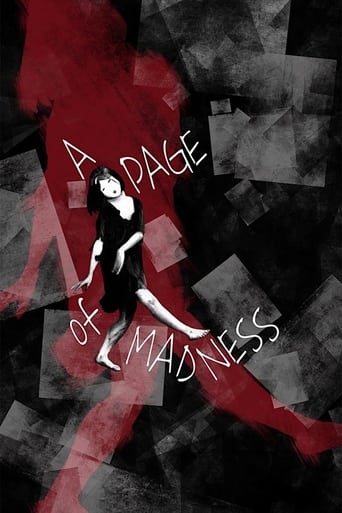max-seitz-1990
Kurutta Ippeji offers a view on the distorted perspective of a troubled janitor in a mental asylum. As a proof of concept, it shows that experimental cinematic techniques can affect the way narration is perceived by the viewer - here, the visual elements contribute to how the viewer experiences the characters' mental state. As an experiment, the movie possibly even makes a stronger case than the comparably surreal Hausu (1977), which is partly imbalanced in its style. However, due to the poor visual quality and the lack of functional storytelling, this experimental feature can't be easily recommended to people looking for a more conventional feature.
Overall 7/10
Full Review on movie-discouse.blogspot.com
thinbeach
I've heard some Japanese silents had a narrator live in the cinema to detail what was happening. But without it, and without intertitles, this film is nigh on unwatchable. The story is impossible to follow. As it stands, it feels not like a story, but a visual art project, in the vain of 'Un Chien Andalou'. To that extent there are a few striking images, with the noir lighting being a highlight, but it is very repetitious. All we see are the same images of women in cells going crazy, and a calm man gazing between the bars. I've read the director had little money while making the film, and it shows, for the same sets are repeated over and over. There really isn't enough material here to warrant a feature length film, and the true madness of the film is that they tried to stretch it so long. 10 or 20 minutes would have been far more suitable.
Michael Neumann
Film history has been negligent in recognizing this landmark silent drama, made in 1926 by pioneering Japanese director Teinosuke Kinugasa, but unknown until 1971, when a surviving print was (literally) unearthed in the director's garden shed. The film was produced in an isolated creative environment far removed from any foreign influence, but is nevertheless a masterpiece of imagery and editing, revealing a stunning visual flair and employing montage techniques as skillfully as anyone since Eisenstein. It tells a powerful, hallucinatory story of a janitor in an insane asylum who wants desperately to help his inmate wife after she attempts suicide, and like Murnau's 'The Last Laugh' unfolds without the crutch of intertitles. The film has aged remarkable little after the better part of a century in limbo, but since its belated rediscovery has yet to earn the acclaim and evaluation it deserves.
netwallah
With rapid intercutting of scenes of insane people in an asylum, and montage/superimposition of images, and vague, interwoven narratives, this is a very hard movie to follow. Apparently a man (Masue Inoue) takes a job as a porter or janitor in an asylum so he can be near his imprisoned wife, and maybe to rescue her. But she's clearly mad, huddled on the floor, with a vacant expression much of the time and fear, misery, and confusion written on her face the rest of the time. The film-maker switches to her point of view sometimes, and we see vague images of her at the side of a pond drowning a baby, or clutching at a drowned child. She's tormented by something. When the point of view shifts to her or other mad folks, the filmmaker uses distorting lenses and such things, showing us what mad people see and then how they react. And the place is swarming with mad folks, laughing, hiding, and in one case dancing frenetically night and day. At one point the man tries to take his wife outside, but the night outside the door terrifies her and she runs back to her cell. Gradually the man slips into a nightmare in which he's interrupted in another attempt to steal her away, and he kills the doctor and many attendants, and all the while the mad folk laugh and applaud. When he wakes he is relieved, and mops the floor. Some fascinating shots of Japanes life, streets, buildings in the 1920s.


 AD
AD


